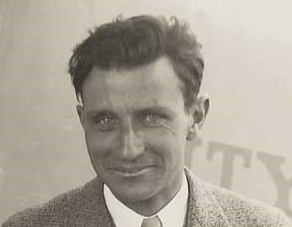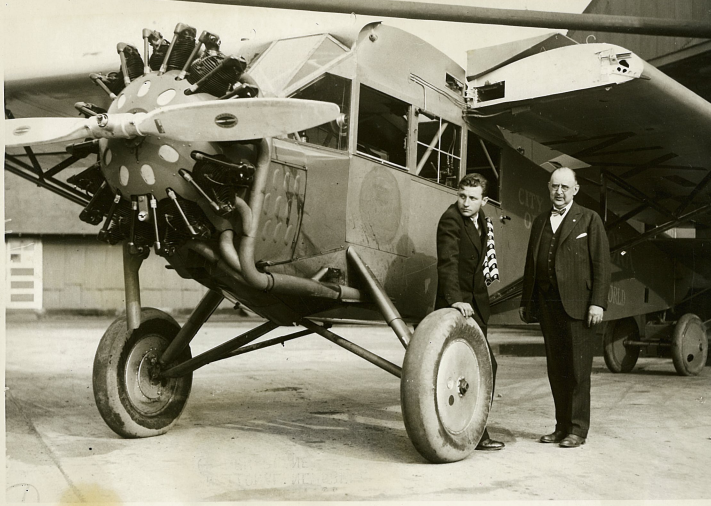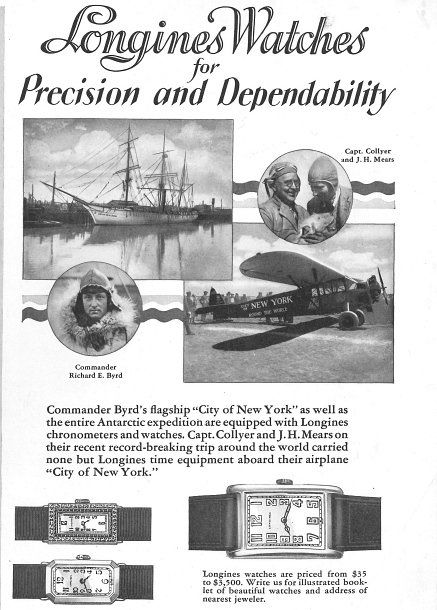
A member of the Longines Honor Roll, Charles Bascum Dury Collyer was among the first set of aviators to complete round the world travel by aircraft. In the early days of flight this was no mean feat. Many pilots had tried and failed, some even lost their life to the journey.
The instruments used for navigation were still experimental and it was up to these brave pilots to test theory and technology alike. In 1928 John Henry Mears, Charles B. D. Collyer and their little white terrier, Tailwind, circled the globe in plane and ship with a time of 23 days, 15 hours and 21 minutes.
Jules Verne’s Around the World in Eighty Days had been completed in well over double that time. This journey would have seemed utterly astonishing to a public reading the book at the end of the nineteenth century.
Even more astonishing that only a few years after 1928 pilots would travel the world in less than 100 hours.

The record before Collyer and Mears was set by Mears himself in 1913; circumnavigating the globe in just 35 days.
Before him, Ferdinand Magellan sailed the world in 3 years during the sixteenth century. Nellie Bly, New York World reporter, took 72 days in 1889.
U. S. Army planes would take 175 days, of which 15 were actual flying days in 1924.[1]
Proceeding Mears and Collyer were Linton Wells and Edward F. Evans with a journey in 28 days, 14 hours and 36 minutes using automobiles, trains, planes and liners. These round the world journeys were gargantuan undertakings in both preparation, navigational study and execution.
In areas that were rarely traversed or entirely unknown it was no simple task. Mears and Collyer prepared for several years on the 1928 attempt to race the moon around the earth.
In order to beat the previous record it ‘was their plan to make speed records over the land stages around the world, mapping out a course that would coincide at terminals with available fast ocean liner services, by which they would span the Atlantic and Pacific Oceans.’[2]
They were to make this journey, as much as possible, by air, only intending to travel by ship under the vastly unknown airspace of the Atlantic and Pacific Oceans.
His First Around the World Trip
They left Battery Seawall, New York in a seaplane on the morning of June 29th, 1928. Collyer and Mears aimed to speed past the express liner, Olympic which had stowed their Fairchild monoplane the day prior. On reaching The City of New York, a Fairchild monoplane, their race with the moon began.
They set an exacting and whirlwind pace throughout their journey. Upon landing at Cherbourg on July 5th they sped around the globe. This is the log kept by Mears:

- July 5: 9:45 P.M. arr. Cologne
- July 6: 4 A.M. lv. Cologne
- July 6: 1:45 P.M. arr. Berlin
- July 6: 5 P.M. arr. Koenigsberg
- July 7: 2 A.M. lv. Koenigsberg
- July 7: (afternoon) arr. Moscow
- July 7: 1:39 P.M. lv. Moscow
- July 7: 6:45 P.M. arr. Kazan
- July 8: 2 A.M. lv. Kazan
- July 8: (no time given) arr. Chita, Siberia, after brief stop at Krasnoyarsk
- July 9: 4 A.M. lv Chita
- July 10: arr. Mukden: off after brief stop
- July 11: 8:13 A.M. arr. Pingyang, Korea
- July 11: 9:10 A.M. lv. Pingyang[3]
From Pingyang they continued on to Tokyo, Yokohama, steaming out of Japan on the Empress of Britain and arriving in Victoria, Canada on July 20th. They flew on to Spokane, reaching Minneapolis on the night of July 21st.
They left the next morning for Miller Field, Staten Island, where they arrived on July 22nd, 6.55 P.M. Collyer had covered 19,725 miles in less than 24 days, traveling faster than the moon around the earth.
This journey was exceptional in that its primary mode of travel was aircraft. The navigation, mapping and timing was precise and accurately prepared.
They were equipped with special chronometers demonstrating how essential chronometric time is to aviation. John P.V. Heinmuller commented that ‘Mears and Collyer were the first to experiment with and to solve problems of correct timing and position calculations.
They really were the pioneers for correct time in the air, and they did much to inspire the progress that has brought us to a precise adaptation of scientific navigation along the illimitable airlines of our world.’[4]
Crucially, they also kept an exact log of fuel consumption which would aid and advise many journeys to come.
Born August 24th, 1896 Collyer went on to pioneer global air travel; testing and making discoveries on a journey that would influence and inform all journeys to come.
In 1928 Collyer set his sights on speed records in a Lockheed Vega NX4769 named Yankee Doodle. Aviation magazine Flight reports on November 1st 1928:
CAPT. C. B. D. COLLYER made a non-stop record flight westwards across America on October 25 in a Lockheed ‘Vega’ monoplane, accompanied by Mr. H. Tucker, owner of the machine. They flew from Long Island to Los Angeles in 24 hrs. 51 mins. beating the previous record from east to west, which was 26 hrs, 50 mins., made by Lieuts. [Register pilots John] Macready and [Oakley] Kelley [sic] in 1923.[5]
Collyer went on to attempt a separate West-East speed record with the same Harry Tucker in November 1928.
Both pilots were killed in a crash 30 miles southeast of Prescott on November 3rd, 1928. A fierce rainstorm threw the plane into the Crook Canyon at the Bradshaw Mountains, Arizona.
On hearing of his death Mears expressed that “I am grieved beyond expression… He was one of the finest men and the best pilot I ever knew.”[6]
Footnotes
- ‘AERONAUTICS: Flights & Flyers,’ Time Magazine, (August 19 1929, Time Magazine), http://dmairfield.com/people/collyer_cb/index.html (date accessed: 26/08/16).
- John P.V. Heinmuller, ‘VIII John Henry Mears and Charles B.D. Collyer,’ Man’s Fight to Fly, (New York: Aero Print Company, 1945), pp. 127.
- John P.V. Heinmuller, ‘VIII John Henry Mears and Charles B.D. Collyer,’ Man’s Fight to Fly, (New York: Aero Print Company, 1945), pp. 128.
- John P.V. Heinmuller, ‘VIII John Henry Mears and Charles B.D. Collyer,’ Man’s Fight to Fly, (New York: Aero Print Company, 1945), pp. 129.
- Flight, (Melanie Robson, November 1, 1928), pp. 959. http://dmairfield.com/people/collyer_cb/index.html (date accessed: 26/08/16).
- Collyer and Tucker Die in Plane Crash,’ The New York Times, (The New York Times, November 5, 1928), http://dmairfield.com/people/collyer_cb/index.html (date accessed: 26/08/16).
Bibliography
Anonymous, ‘AERONAUTICS: Flights & Flyers,’ Time Magazine, (August 19 1929, Time Magazine), http://dmairfield.com/people/collyer_cb/index.html (date accessed: 26/08/16).
Anonymous, ‘Collyer and Tucker Die in Plane Crash,’ The New York Times, (The New York Times, November 5, 1928), http://dmairfield.com/people/collyer_cb/index.html (date accessed: 26/08/16).
Anonymous, Flight, (Melanie Robson, November 1, 1928), pp. 959. http://dmairfield.com/people/collyer_cb/index.html (date accessed: 26/08/16).
Heinmuller, John P.V. ‘VIII John Henry Mears and Charles B.D. Collyer,’ Man’s Fight to Fly, (New York: Aero Print Company, 1945)
